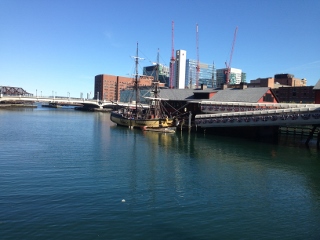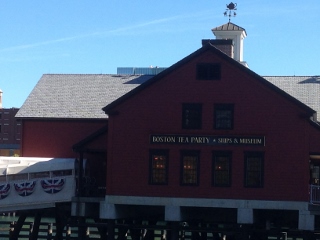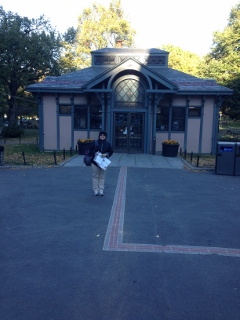 Click on Image |
The Start of the Freedom Trail -- Follow the Red Brick/Line ... Located at the Visitor Center in Boston Common. Freedom Trial Map Another Map |
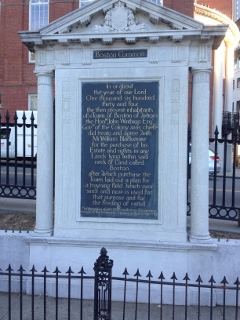 Click on Image |
Boston Common - Established in 1634, is America’s oldest public park. Puritan colonists purchased the land rights to the Common’s 44 acres from the first settler of the area, Anglican minister William Blackstone. The price was 30 pounds, and each homeowner paid him six shillings. The pasture then became known as the "Common Land" and was used to graze local livestock until 1830. A town shepherd was paid "two shillings and sixpence per head of cowe" to tend townspeople’s livestock. | 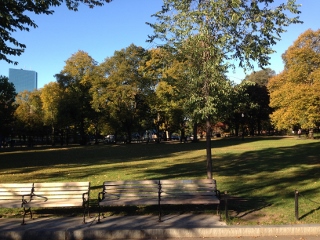 Click on Image |
Boston Common -
Also referred to as a "trayning field," over 1000 Redcoats made camp on the Common during the British occupation of Boston in 1775. It was from here that three brigades of Redcoats left to make the fateful
trip to Lexington and Concord. Boston Common was a place for celebration as well; bonfires and fireworks celebrated the repeal of the Stamp Act and the end of the Revolutionary War. Boston Common has, and continues to, serve a higher purpose as a place for public oratory and discourse. |
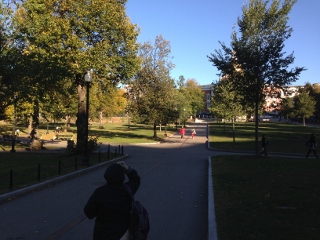 Click on Image |
Boston Common - The Common was a site for Puritanical punishments, home to a whipping post and stocks. Pirates, murderers, and witches were hanged from the tree known as "The Great Elm," now gone. Mary Dyer and three other Quakers were also hanged on the Common for their beliefs. A statue of Mary Dyer now stands on the Massachusetts State House lawn. |  Click on Image |
Massachchusetts State House - Designed by Charles Bulfinch, the Massachusetts State House was completed on January 11, 1798, and is widely acclaimed as one of the more magnificent public buildings in the country. The land for the State House was originally used as John Hancock’s cow pasture. Its most distinct feature, the golden dome, was once made of wood, but was later overlaid with copper by Paul Revere. It was covered with 23-karat gold leaf for the first time in 1874. | 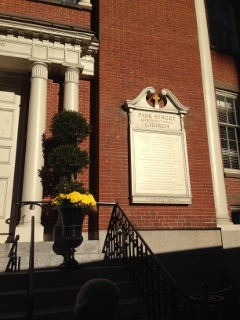 Click on Image |
Park Street Church - The church was founded in 1809, at the corner of Park and Tremont Streets, atop the site of Boston’s town grain storage building, or granary. Designed by Peter Banner, the 217 ft. steeple of Park Street Church was once the first landmark travelers saw when approaching Boston. Park Street Church became known for supporting Abolitionist causes where, on July 4, 1829, a young William Lloyd Garrison delivered his first major public speech against slavery. |  Click on Image |
Park Street Church - The Park Street Church site was formerly called "Brimstone Corner." It may have gotten the nickname during the War of 1812 when the C ongregationalists stored brimstone (a component of gunpowder) in the basement. Or perhaps it’s because old-school Congregationalist ministers preached many a "hell-fire and brimstone" sermon here. |  Click on Image |
Granary Burying Ground - Established in 1660, some of America's most notable citizens rest here. Named for the 12,000-bushel grain storage building that was once next door, the historic cemetery has 2,300 markers. However, there is a discrepancy between the number of headstones and the number of people buried in the Granary - it is estimated there are over 5,000 Bostonians who have made the Granary their final resting place. | 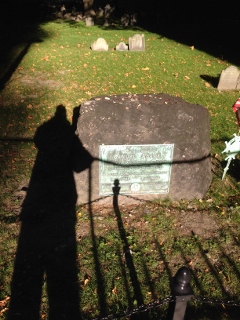 Click on Image |
Granary Burying Ground - Samuel Adams Gravesite | 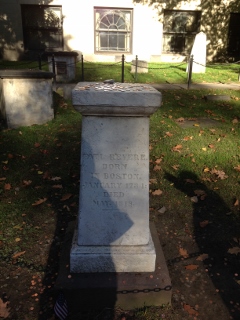 Click on Image |
Granary Burying Ground - Paul Revere Gravesite | 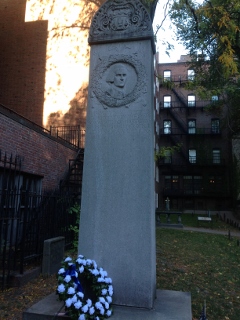 Click on Image |
Granary Burying Ground - John Handcock Gravesite | 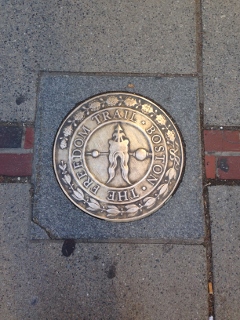 Click on Image |
Freedom Trail - One of Seventeen Markers Deplicting Boston Historical Site | 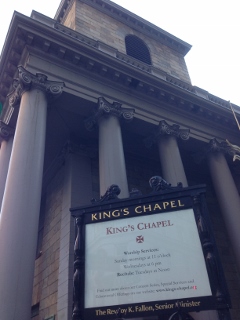 Click on Image |
King's Chapel - In 1688, Royal Governor Andros directed that King’s Chapel be built on a town burying ground when no one in the city would sell the congregation desirable land on which to build a non-Puritan church. The present granite structure was built around the original wooden chapel, which was then removed through the windows of the new construction and rebuilt as an Anglican chapel in Nova Scotia. The congregation hired America’s first architect, Peter Harrison, to design a church “that would be the equal of any in England.” The new church was completed in 1754. Harrison’s plans included a steeple, which has never been built, and a colonnade, which was not completed until after the Revolution. | 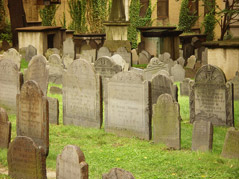 Click on Image |
King's Chapel Burying Ground - King’s Chapel Burying Ground was Boston Proper’s first burying ground. It boasts a multitude of illustrious residents, including John Winthrop, Massachusetts’ first Governor, and Mary Chilton, the first woman to step off the Mayflower. | 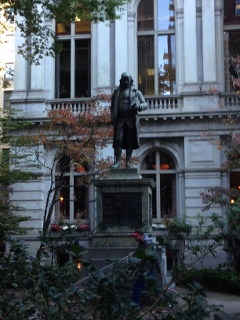 Click on Image |
Benjamin Franklin Statue & Boston Latin School - Statue of Benjamin Franklin | 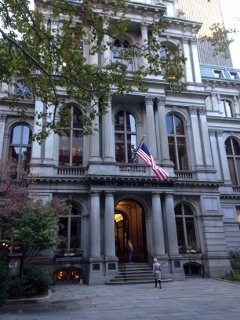 Click on Image |
Benjamin Franklin Statue & Boston Latin School - Old City Hall of Boston was one of the first buildings in the French Second Empire Style to be built in the United States and is now one of the few that survive. The location itself is significant in the history of the nation. The Boston Latin School (1635), Boston's first public school and the oldest educational institution in the country, stood here first. Some notable figures in history who attended this school include Cotton Mather, Benjamin Franklin, John Hancock, and Samuel Adams. | 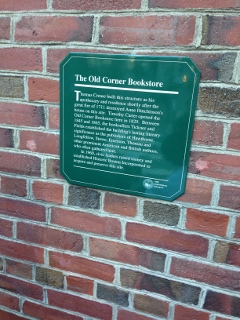 Click on Image |
The Old Corner Book Store - Bookstore The oldest commercial building in Boston, the Old Corner Bookstore was built in 1718 as an apothecary shop and home on property that once belonged to Puritan dissident Anne Hutchinson. | 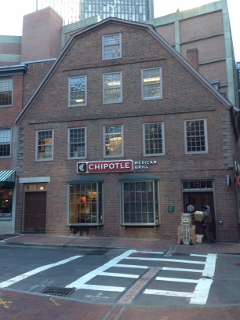 Click on Image |
The Old Corner Book Store - The Old Corner Bookstore was the center of American book publishing in the mid-1800s when Boston was the country's literary mecca. From this place, publishers Ticknor and Fields produced the works of Henry Wadsworth Longfellow, Harriet Beecher Stowe, Nathaniel Hawthorne, Ralph Waldo Emerson, John Greenleaf Whittier, Oliver Wendell Holmes Sr., and Louisa May Alcott, many of whom were frequent visitors to the building. | 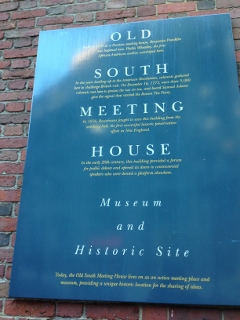 Click on Image |
Old South Meeting House - Built in 1729, Old South Meeting House was not a church, but rather a meeting house for the Puritans to worship. Old South Meeting House was the biggest building in all of colonial Boston and the stage for some of the most dramatic events leading up to the American Revolution, including the meeting that occurred on December 16, 1773. Over 30 tons of taxable tea sat in the holds of three ships moored at Griffin's Wharf, the Dartmouth, the Eleanor, and the Beaver. | 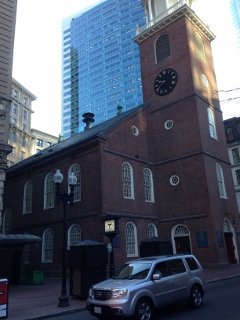 Click on Image |
Old South Meeting House - If the tea was unloaded, a tax would have to be paid to England - and people did not want to pay the tea tax when they had no representative in British government. Five thousand colonists crowded into Old South Meeting House to decide what was to be done with the tea. After the failure of a final attempt to have the tea sent back to England, Samuel Adams addressed the crowd, saying, "This meeting can do nothing more to save the country." These words were rumored to be a secret signal to the Sons of Liberty disguised as Mohawk Indians to march down to Griffin’s Wharf and destroy 340 crates of tea, dumping them into the harbor. This event became known as the Boston Tea Party. | 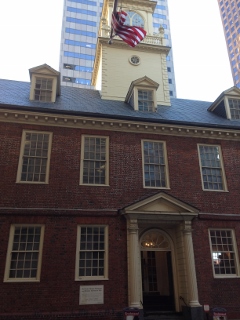 Click on Image |
Old State House - The Old State House has stood as an emblem of liberty in Boston for over 300 years! Built in 1713 to house the colony’s government, the Old State House was at the center of civic events that sparked the American Revolution. James Otis railed against the Writs of Assistance in a fiery speech that ignited the colonists’ rebellion. “Then and there the child independence was born,” John Adams declared. In 1768, the colony’s House of Representatives defied the royal governor and refused to rescind their call for united resistance to British taxes. | 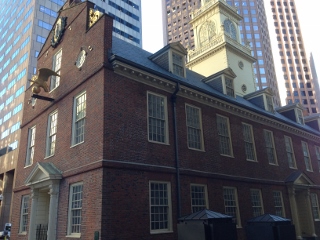 Click on Image |
Old State House - Patriots everywhere toasted House members for their courage; British officials, however, dissolved the legislature and sent two regiments of the army to occupy Boston. Less than a decade later, in 1776, the Declaration of Independence was first read to the people of Boston from the Old State House balcony, and the building became home to the newly-formed government of the Commonwealth of Massachusetts. | 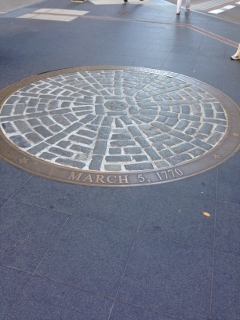 Click on Image |
The Boston Massacre - The tensions that led to the Boston Massacre were the product of the occupation of Boston by Redcoats in 1768. Redcoats were sent to Boston to quell riots in the wake of the Townsend Duties and to protect customs officials. With 2,000 soldiers occupying a town with a population of about 16,000, friction was inevitable. This would occasionally produce fist fights and angry confrontations. The violent clash on March 5, 1770 began when Private White, on guard at the Customs house on King Street (now State Street) struck young Edward Garrick in the face with the butt of his musket for insulting White's commanding officer. White soon found himself surrounded by an angry mob of Bostonians that hurled taunts and snowballs at him. | 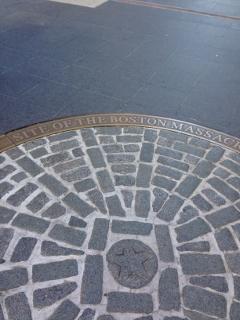 Click on Image |
The Boston Massacre - Captain Preston of the 29th Regiment arrived with eight fellow Redcoats to extract White from the square. The troops forced their way through the increasingly hostile crowd. According to some witnesses, amidst a hail of snowballs and rocks, a club thrown from the crowd struck Private Montgomery in the face. Witnesses said Montgomery then fired the first shot. The crowd continued to press on the soldiers and more shots were fired. When the smoke cleared, five men lay dead or dying. | 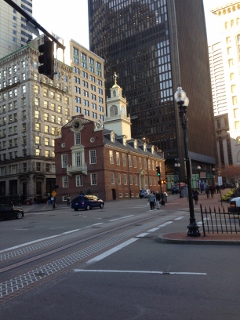 Click on Image |
Old State House & The Boston Massacre - View of the Old State House with The Boston Massacre Marker right in front of it (located at the street corner). | 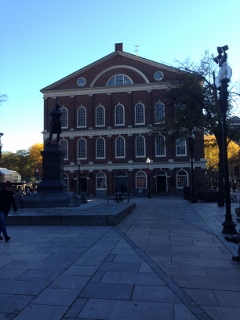 Click on Image |
Faneuil Hall - Often referred to as "the home of free speech" and the "Cradle of Liberty," Faneuil Hall hosted America's first Town Meeting. The Hall's vital role in revolutionary politics had not been part of its original plans, but it became home to an intricate collection of events that shaped the nation's history. Built by wealthy merchant Peter Faneuil as a center of commerce in 1741, this is where the Sons of Liberty proclaimed their dissent against Royal oppression. It was at Faneuil Hall in 1764 that Americans first protested against the Sugar Act and the Stamp Act, setting the doctrine that would come to be known as "no taxation without representation." Gatherings to protest the Townshend Acts, the Redcoat occupation, and the Tea Act would follow. | 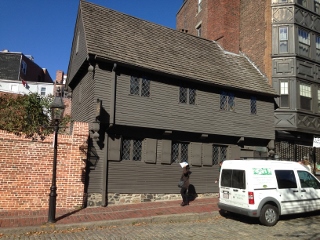 Click on Image |
Paul Revere House - Built around 1680, the Paul Revere House is the oldest remaining structure in downtown Boston and the only home on the Freedom Trail. Paul Revere purchased the former merchant's dwelling in 1770, when he was 35 years old. He and his family lived here when Revere made his famous messenger ride to Lexington on the night of April 18-19, 1775 that would be immortalized by Longfellow’s famous poem Paul Revere’s Ride. At various times, Revere shared this house with his mother and nine of his children from two marriages. His first wife, Sarah, died following the birth of their eighth child and Rachel, his second wife, bore him another eight. |  Click on Image |
The Freedom Trail - Statue of Paul Revere | 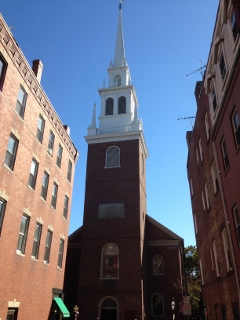 Click on Image |
Old North Church - Christ Church in the City of Boston, also known as Old North Church, is the oldest standing church building in Boston, having first opened its doors to worshippers on December 29, 1723. Its 191 foot steeple is the tallest in Boston and, because of its prominence, would play a dramatic role in the American Revolution and would be immortalized in Henry Wadsworth Longfellow's poem The Midnight Ride of Paul Revere. | 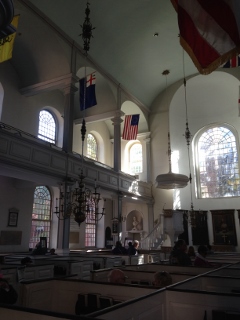 Click on Image |
Old North Church - On April 18, 1775 Paul Revere met up with the sexton Robert Newman to tell him how to signal the advancement of British troops towards Lexington and Concord. Newman then met fellow Sons of Liberty Captain Pulling and Thomas Bernard. Leaving Bernard to keep watch outside, Newman opened the church and he and Pulling climbed the stairs and ladders up eight stories to hang two lanterns for a few moments. It was long enough for patriots in Charlestown to learn what has been immortalized by the phrase "one if by land, two if by sea" in Longfellow’s poem. The British were advancing by boat across the Charles River. | 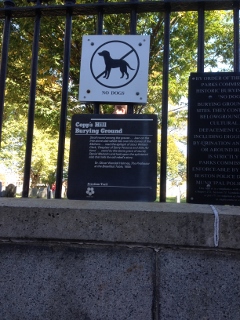 Click on Image |
Copp's Hill Burying Ground - Copp’s Hill was Boston’s largest colonial burying ground, dating from 1659. The burying ground also holds Old North Church sexton Robert Newman, the man who hung the lanterns on the night of Paul Revere’s midnight ride and Edmund Hartt, builder of the USS Constitution. Because of its height and panoramic vistas, the British used this vantage point to train their cannons on Charlestown during the Battle of Bunker Hill in 1775. The epitaph on Captain Daniel Malcolm's tombstone at Copp's Hill is riddled with the marks of vengeful British bullets. | 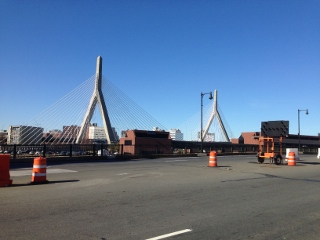 Click on Image |
The Freedom Trail - Bridge with unusual architecture seen in many movies and series. | 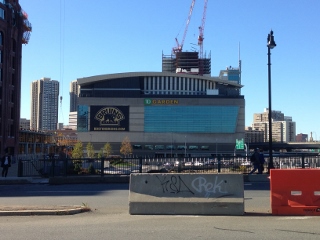 Click on Image |
The Freedom Trail - TD (Boston) Garden: Home to The Celtics and Bruins | 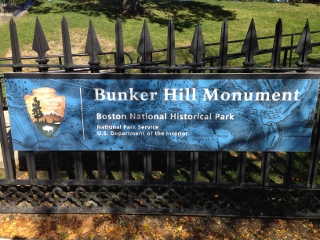 Click on Image |
Bunker Hill - The Battle of Bunker Hill on June 17, 1775, was the first major battle of the Revolutionary War and predicted the character and outcome of the rest of the war. It took a force of 3,000 Redcoats three assaults to dislodge the Colonial Militia from a hastily constructed redoubt atop Breed’s Hill in Charlestown. It was in this battle that, "don't fire until you see the whites of their eyes!" is said to have been uttered by Colonel William Prescott and has come to immortalize the determination of the ill-equipped Colonists. While technically a British victory, the Battle of Bunker Hill proved that Colonial forces could fight effectively against the British. | 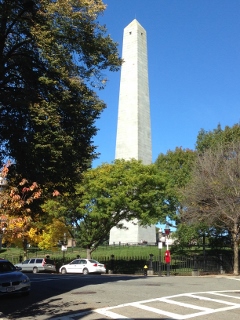 Click on Image |
Bunker Hill - 297 Steps to the top! |  Click on Image |
Bunker Hill - Monument Historical Marker | 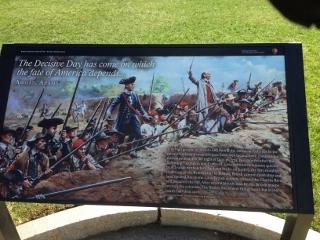 Click on Image |
Bunker Hill - Historical Marker | 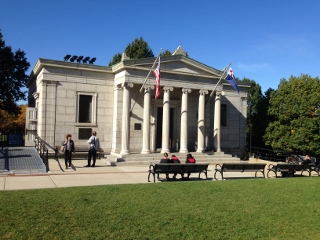 Click on Image |
Bunker Hill - Confusion about the name of the hill where the battle occurred goes back to the battle itself. Colonel William Prescott’s orders were to fortify Bunker’s Hill but he chose Breed’s Hill instead. A detailed map of the battle prepared by British Army Lieutenant Page reversed the two hills. Whatever the original error, the conflict was always known as the Battle of Bunker Hill. | 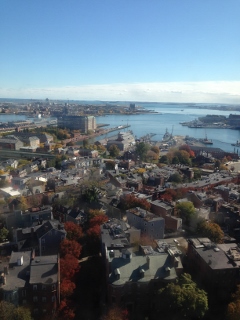 Click on Image |
Bunker Hill - View of Boston Harbor from the top of the Monument | 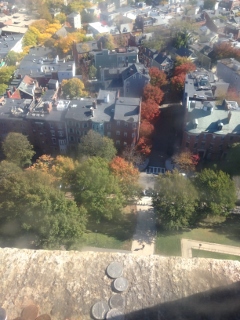 Click on Image |
Bunker Hill - Looking down on Bunker Hill from the Monument. | 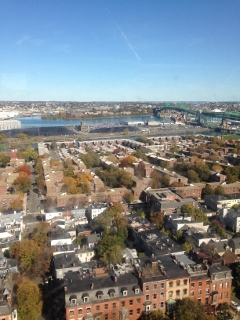 Click on Image |
Bunker Hill - View from Monument looking away from Harbor | 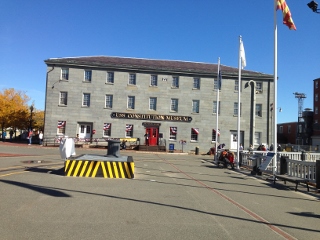 Click on Image |
USS Constitution - USS Constitution Museum | 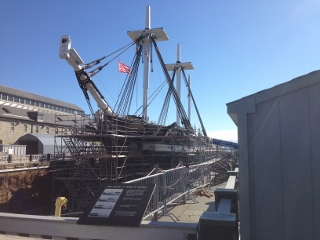 Click on Image |
USS Constitution - Launched in Boston in 1797, the oldest commissioned warship afloat earned her nickname "Old Ironsides" during the War of 1812 when she fought the British frigate HMS Guerriere. During this historic battle, cannonballs fired at USS Constitution appeared to bounce off, causing one of her crew to remark that her sides were made of iron. In fact, the durability of Constitution is attributed to a three-layer wooden sandwich of live oak and white oak from all across America. The ship’s copper fastenings were constructed by Paul Revere. | 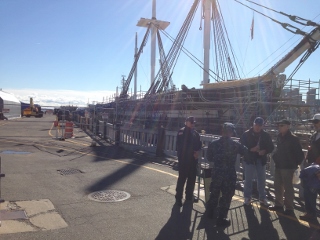 Click on Image |
USS Constitution - The USS Constitution is a well-traveled ship, having patrolled the West Indies, Brazil, and the West African coast and participated in the Barbary Wars. The ship is permanently berthed in the Charlestown Navy Yard and ventures out several times a year into Boston Harbor, most notably on July 4th to celebrate our nation's Independence Day. Today, more than 216 years later, she is still a commissioned U.S. Navy warship with a crew of naval officers and enlisted personnel. |
Return
